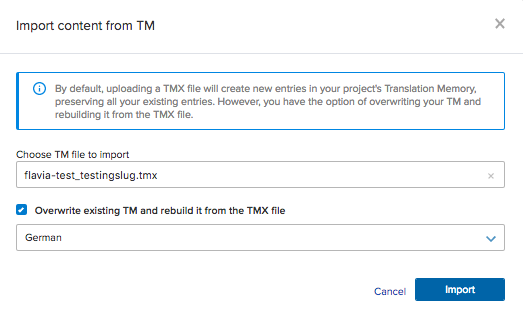Localization projects evolve, and sometimes your Translation Memory ™ can become cluttered with old, unused, or inaccurate segments from past source strings. This can lead to lower TM match quality and inaccurate reporting.
This guide details a powerful technique to create a new, clean TMX file containing only the latest, accepted translations from your current project strings, which you can then use to overwrite and refresh your existing TM.
The Goal: A Fresh TM with Only Current Data
The standard Transifex workflow ensures that every translation made is saved to the TM. However, when a source string is updated, the old source-translation pair remains in the TM. The goal of this process is to essentially export the current state of translations in your project as a clean TMX file.
Prerequisites
-
Administrative Access to your Transifex Organization.
-
The ability to create a new, temporary Project.
-
The ability to download resources and translations from your current project.
Step-by-Step Guide: Creating the Clean TMX
Step 1: Create a Temporary Project
-
Navigate to your Transifex Organization and create a new, temporary Project. Give it a descriptive name like “TM_Cleanup_TEMP.”
-
Ensure this new project has the exact same target languages as your main project.
Step 2: Upload Source Files to the Temp Project
To “anchor” the new TM entries, we must first load the source strings into the temporary project.
- From your main, existing project, download the latest source file(s) for the resources you wish to clean up. This can be done either from the UI or for a more automated process using our GO Cli, or any script generated that uses our API.
![]() **Quick Tip ** This can also work for fileless resources found in native and TX live projects. We can use the API to download source strings as a json file and use that file to the temp project.
**Quick Tip ** This can also work for fileless resources found in native and TX live projects. We can use the API to download source strings as a json file and use that file to the temp project.
- In the Temporary Project, upload these source files to create the resources. This ensures the temporary project has the most up-to-date source content.
Step 3: Upload Translations to the Temp Project
This is the critical step that generates the clean TM entries.
-
From your main, existing project, download the latest translation files (e.g.,
.po,.json, etc.) for all the relevant target languages.- Tip: Make sure you check the most appropriate download mode for the file format you have so that empty translations do not have a copy of source (eg. translator mode for json files downloaded with API or CLI or “To Translate“ if you use the UI)
-
In the Temporary Project, upload these translation files back into the corresponding resources.
- Transifex will automatically apply these translations. Because this is a new project, every applied translation will be logged as a new entry in the organization’s TM, based on the current source string.
Step 4: Download the Clean TMX
Now that the TM has been updated with clean, current source-translation pairs from the temporary project, we can download the consolidated file.
-
Navigate to the Translation Memory section of your Transifex Organization.
-
Select the option to Download the TMX file. This file will now include the freshly generated, current entries from the temporary project alongside any existing entries.
Step 5  CRITICAL SAFETY NOTE
CRITICAL SAFETY NOTE
Please make sure you back up your old TM memory just in case something goes wrong! This process involves overwriting your existing Translation Memory, and while the steps are designed for safety, having a backup is your definitive safety net to restore your TM if the new import does not proceed as expected.
Step 6: Overwrite the Old TM
The final step is to use the clean TMX file to replace your old, cluttered TM.
-
In the Translation Memory section, select the option to Import content from a TMX file.
Details here. -
Crucially, select the option to overwrite the existing TM.
Once the import is complete, your Translation Memory will be “spring-cleaned,” containing only the current, active translations from your projects, significantly improving the quality of TM matches and reducing noise from old segments!
Step 7: Cleanup
- Delete the Temporary Project (e.g., “TM_Cleanup_TEMP”). All the clean TM entries generated will remain in your organization’s TM.
This way, you can “clean up” your cluttered TM memory with some simple steps and without the need to edit a large TMX file.
You are set with only the latest translations for an automated TM fill-up.
